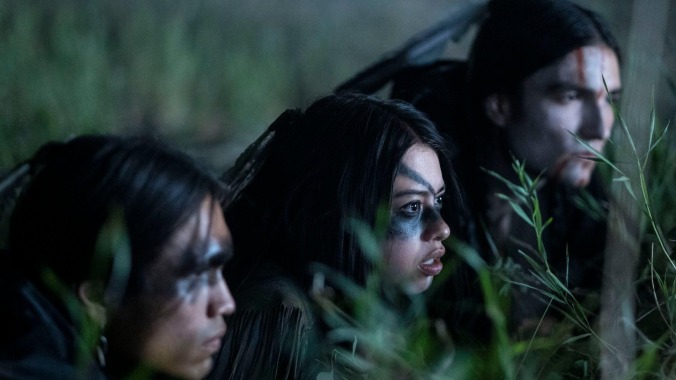Prey moves the Predator franchise forward, by taking it back in time
By focusing on the stories of the human characters—in a uniquely anachronistic setting—director Dan Trachtenberg rekindles interest in the uneven film series

There’s a fallacy in thinking each subsequent entry of a franchise needs to go bigger. What worked well for Aliens and Terminator 2: Judgment Day, simply isn’t applicable to every 80s-born sci-fi/action franchise that Hollywood repeatedly attempts to reinvigorate. With Dan Trachtenberg’s Prey, the long-running Predator franchise finally has an entry that can stand as an equal to the original film, precisely because it narrows its focus on the story elements that matter dramatically, instead of unnecessarily expanding the franchise’s mythology.
A prequel to Predator, Prey is set in 1719, following Naru (Amber Midthunder), a young Comanche warrior who wants to break the gender traditions of her tribe and become a hunter. Already a skilled tracker and healer, Naru’s strength is put to the test when an unseen adversary endangers her tribe. Within this new setting, Trachtenberg strips the Predator franchise back down to its core elements—the ruthlessness of this alien species and the ingenuity of humanity when confronted with nearly impossible odds. In concentrating on character and location, he backs off of the world-changing repercussions of the franchise’s immediate predecessors, creating an involving and tense character-driven experience whose strengths rely on narrative simplicity and a compelling lead in Midthunder.
Populated by American Indian characters as opposed to the glistening, muscle-bound military men of McTiernan’s film, Prey immediately sets itself apart from its predecessors. Written by Patrick Aison, the script takes its time before launching into the Predator’s bloodshed, grounding the audience in the Comanche’s decidedly anachronistic 1700s culture before shifting into its more contemporary genre elements. Aison establishes what hunting means to the Comanche, defines the roles expected of men and women in their tribe, and spotlights Naru’s competitive relationship with her older brother, Taabe, who’s played with empathy and star-making confidence by newcomer Dakota Beavers. Trachtenberg and cinematographer Jeff Cutter, reteaming from their work on 10 Cloverfield Lane (2016), take great lengths to create a sense of naturalism and beauty, both in the landscape and performances, that leads naturally into the eventual showdown with an alien audiences know is waiting in the brush.
After a close call with a mountain lion that the tribe takes as an indication that Naru isn’t meant to be a hunter, she sets out alone to find out what’s threatening her home. Midthunder lends Naru’s ambitions exudes a restless impatience that hardens into self-assurance, and eventually, lethal opposition to the Predator. It’s impossible not to think of Sigourney Weaver’s Ellen Ripley and Linda Hamilton’s Sarah Connor when watching Midthunder go through the wringer and emerging, bloodied and determined, to continue the fight. Trachtenberg took a similar approach to directing Mary Elizabeth Winstead in 10 Cloverfield Lane, but there is something particularly fresh and exciting about seeing an American Indian actress breathe life into what has become an iconic arc.
After Naru’s first confrontation with the Predator, the film continuously escalates and it becomes a gauntlet run of near escapes and propulsive action, depicted in decidedly cool but never larger-than-life terms. Stunt coordinators Steven McMichael and Jeremy Marinas conjure magic magic with mostly primitive weapons like bows and arrows, hatchets, and swords, giving the fights the kind of brisk pacing and visceral impact that action junkies expect in a post-John Wick film landscape. Once a group of French hunters joins the Predator’s list of targets, Prey not only delivers gore in spades but provides some of the best moments in the franchise. Playing the extraterrestrial beast, Dane DiLiegro offers arguably the most savage iteration of the species we’ve yet seen, ignoring the mischievous humor McTiernan gives them in his film, making their pursuit all the more threatening, especially opposite the lithe, stealthy Naru.
It’s clear that while the filmmakers are taking the property seriously, they’re also having fun. Alongside their respect for the Comanche, to whom the film is dedicated (and producer Jhane Meyers is a Comanche and Blackfeet American Indian, ensuring respect and authenticity in its depictions of their culture), there is a giddiness in the filmmaking that suggests that the film was a passion project for all involved. There are several callbacks to the first film Trachtenberg and his collaborators deftly work into key moments, but Prey creates new iconic moments that set apart this entry, while helping the series continue, and even evolve.
This is the shot in the arm that the franchise needed—a confident addition to its timeline, populated with moments that will leave long-time fans grinning and will encourage newcomers to explore the rest of the franchise. Additionally a win for genre film representation, Prey knows exactly what it wants to be, expanding the Predator mythos by creating traditions among the human characters that are as meaningful, or more, than their alien foes. More franchise filmmaking should be like this—despite the fact that it’s headed to Hulu, its intimacy deserves to be seen on the biggest scale possible.